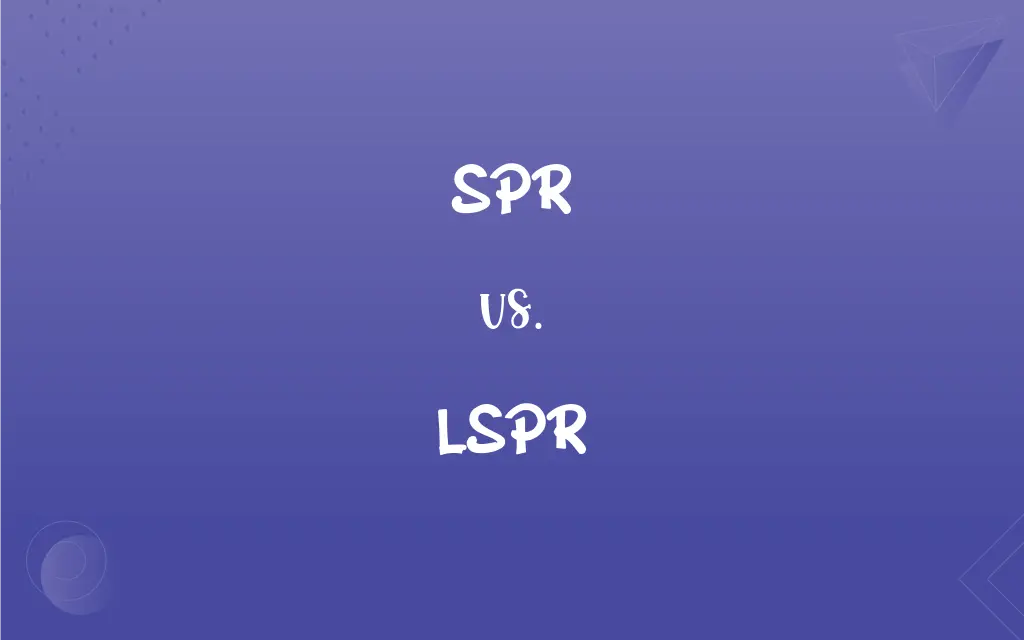SPR vs. LSPR: What's the Difference?
Edited by Aimie Carlson || By Harlon Moss || Published on February 9, 2024
SPR (Surface Plasmon Resonance) is a technique for measuring molecular interactions, while LSPR (Localized Surface Plasmon Resonance) is a similar technique but utilizes nanoparticles for enhanced sensitivity.

Key Differences
SPR is a widely used method for analyzing molecular interactions, such as between a drug and its target, by measuring changes in the refractive index near a sensor surface. LSPR, on the other hand, is a more specialized version of SPR that uses nanoparticles, usually made of noble metals, to enhance sensitivity and specificity.
In SPR, a light beam is directed at a thin metal film, causing an electron charge density wave at the metal-dielectric interface, sensitive to changes in the nearby environment. LSPR operates on a similar principle but localizes the plasmon resonance to the surface of nanoparticles, which can be more precisely controlled and modified.
SPR is known for its ability to provide real-time, label-free analysis of biomolecular interactions. LSPR enhances this capability by offering higher sensitivity due to the localized plasmon effects of nanoparticles, allowing for the detection of smaller quantities of analyte.
The applications of SPR are broad, including drug discovery, antibody testing, and protein interaction studies. LSPR is particularly advantageous in applications requiring ultra-sensitive detection, such as in diagnostic assays or environmental sensing.
SPR requires a planar sensor surface and is often used in a flow cell setup. In contrast, LSPR can be used with a variety of nanoparticle shapes and sizes, providing flexibility in design and application.
ADVERTISEMENT
Comparison Chart
Aspect
SPR
LSPR
Principle
Measures refractive index changes at a sensor surface
Utilizes localized plasmon resonance on nanoparticles
Sensitivity
High
Higher, due to nanoparticle usage
Applications
Drug discovery, protein studies
Ultra-sensitive assays, diagnostics
Setup
Requires planar sensor surfaces
Flexible, uses various nanoparticle designs
ADVERTISEMENT
Technique Specialization
General biomolecular interaction analysis
Specialized for enhanced detection sensitivity
SPR and LSPR Definitions
SPR
SPR is used for real-time, label-free analysis.
SPR allows scientists to observe antibody-antigen interactions in real-time.
LSPR
It's specialized for ultra-sensitive detection.
LSPR can detect trace amounts of biomolecules, crucial for early diagnostics.
SPR
SPR is a method for analyzing molecular interactions.
SPR is vital in drug development for studying drug-target interactions.
LSPR
It's used in environmental sensing.
LSPR sensors can detect pollutants at very low concentrations.
SPR
It measures changes in refractive index.
In SPR, binding events alter the refractive index at the sensor surface.
LSPR
LSPR operates on localized plasmon resonance.
The localized resonance in LSPR allows for high specificity in molecular detection.
SPR
It's widely used in protein interaction studies.
SPR helps in understanding protein-protein interactions in cellular processes.
LSPR
LSPR is a sensitive technique utilizing nanoparticles.
LSPR's use of gold nanoparticles enhances its detection capabilities.
SPR
SPR technology is integral in antibody testing.
SPR is employed in the rapid testing of antibodies in serum samples.
LSPR
LSPR provides flexibility in nanoparticle design.
The diverse shapes of nanoparticles used in LSPR cater to different analytical needs.
FAQs
What is the main advantage of SPR?
SPR provides real-time, label-free analysis of molecular interactions.
Can SPR be used in drug discovery?
Yes, SPR is widely used in drug discovery for studying interactions between drugs and targets.
How does LSPR differ in sensitivity compared to SPR?
LSPR offers enhanced sensitivity due to localized plasmon effects on nanoparticles.
What type of nanoparticles are used in LSPR?
Noble metal nanoparticles, like gold or silver, are commonly used in LSPR.
What applications are suitable for LSPR?
LSPR is suitable for applications requiring ultra-sensitive detection, like early-stage diagnostics and environmental sensing.
What makes LSPR particularly useful in diagnostics?
Its ultra-sensitive detection capability makes it ideal for diagnostics.
Is SPR a label-free technique?
Yes, SPR is a label-free technique, meaning it does not require labeled components to detect interactions.
Is LSPR more flexible in terms of design compared to SPR?
Yes, LSPR offers more flexibility due to the variety of nanoparticle shapes and sizes that can be used.
What is the principle behind SPR?
SPR operates on the principle of measuring refractive index changes at a sensor surface.
Can SPR detect protein interactions?
Yes, SPR is commonly used to study protein interactions.
What industries benefit from SPR?
Industries like pharmaceuticals, biotechnology, and healthcare benefit from SPR.
Can LSPR be used for environmental monitoring?
Yes, LSPR is effective in environmental monitoring, especially for detecting low concentrations of pollutants.
How does the setup of SPR and LSPR differ?
SPR typically requires a planar sensor surface, whereas LSPR can utilize various nanoparticle designs.
Can SPR provide quantitative data?
Yes, SPR can provide quantitative data on molecular interactions.
What makes SPR suitable for antibody testing?
SPR's ability to analyze interactions in real-time without labels makes it suitable for antibody testing.
Are there any limitations to LSPR?
LSPR may have limitations in terms of cost and the complexity of nanoparticle synthesis.
How does the sensitivity of LSPR compare to traditional methods?
LSPR's sensitivity is generally higher than traditional methods due to the enhanced effects of nanoparticles.
What factors influence the performance of LSPR?
Factors like nanoparticle size, shape, and material composition influence LSPR performance.
Is specialized equipment needed for SPR?
Yes, specialized equipment like an SPR biosensor is required for SPR analysis.
What advancements have been made in LSPR technology?
Recent advancements in LSPR include improved nanoparticle synthesis and integration with microfluidic systems for enhanced analysis.
About Author
Written by
Harlon MossHarlon is a seasoned quality moderator and accomplished content writer for Difference Wiki. An alumnus of the prestigious University of California, he earned his degree in Computer Science. Leveraging his academic background, Harlon brings a meticulous and informed perspective to his work, ensuring content accuracy and excellence.
Edited by
Aimie CarlsonAimie Carlson, holding a master's degree in English literature, is a fervent English language enthusiast. She lends her writing talents to Difference Wiki, a prominent website that specializes in comparisons, offering readers insightful analyses that both captivate and inform.

































































